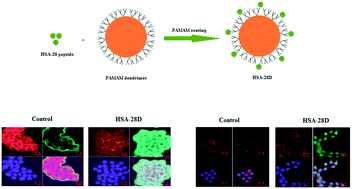Neuroligin-2-derived peptide-covered polyamidoamine-based (PAMAM) dendrimers enhance pancreatic β-cells' proliferation and functions†
Abstract
Pancreatic β-cell membranes and presynaptic areas of neurons contain analogous protein complexes that control the secretion of bioactive molecules. These complexes include the neuroligins (NLs) and their binding partners, the neurexins (NXs). It has been recently reported that both insulin secretion and the proliferation rates of β-cells increase when cells are co-cultured with full-length NL-2 clusters. The pharmacological use of full-length protein is always problematic due to its unfavorable pharmacokinetic properties. Thus, NL-2-derived short peptide was conjugated to the surface of polyamidoamine-based (PAMAM) dendrimers. This nanoscale composite improved β-cell functions in terms of the rate of proliferation, glucose-stimulated insulin secretion (GSIS), and functional maturation. This functionalized dendrimer also protected β-cells under cellular stress conditions. In addition, various novel peptidomimetic scaffolds of NL-2-derived peptide were designed, synthesized, and conjugated to the surface of PAMAM in order to increase the biostability of the conjugates. However, after being covered by peptidomimetics, PAMAM dendrimers were inactive. Thus, the original peptide-based PAMAM dendrimer is a leading compound for continued research that might provide a unique starting point for designing an innovative class of antidiabetic therapeutics that possess a unique mode of action.



 Please wait while we load your content...
Please wait while we load your content...